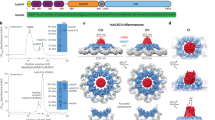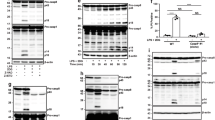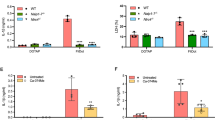Abstract
Inflammasomes are a family of cytosolic multiprotein complexes that initiate innate immune responses to pathogenic microbes by activating the caspase 1 protease1,2. Although genetic data support a critical role for inflammasomes in immune defence and inflammatory diseases3, the molecular basis by which individual inflammasomes respond to specific stimuli remains poorly understood. The inflammasome that contains the NLRC4 (NLR family, CARD domain containing 4) protein was previously shown to be activated in response to two distinct bacterial proteins, flagellin4,5 and PrgJ6, a conserved component of pathogen-associated type III secretion systems. However, direct binding between NLRC4 and flagellin or PrgJ has never been demonstrated. A homologue of NLRC4, NAIP5 (NLR family, apoptosis inhibitory protein 5), has been implicated in activation of NLRC4 (refs 7–11), but is widely assumed to have only an auxiliary role1,2, as NAIP5 is often dispensable for NLRC4 activation7,8. However, Naip5 is a member of a small multigene family12, raising the possibility of redundancy and functional specialization among Naip genes. Here we show in mice that different NAIP paralogues determine the specificity of the NLRC4 inflammasome for distinct bacterial ligands. In particular, we found that activation of endogenous NLRC4 by bacterial PrgJ requires NAIP2, a previously uncharacterized member of the NAIP gene family, whereas NAIP5 and NAIP6 activate NLRC4 specifically in response to bacterial flagellin. We dissected the biochemical mechanism underlying the requirement for NAIP proteins by use of a reconstituted NLRC4 inflammasome system. We found that NAIP proteins control ligand-dependent oligomerization of NLRC4 and that the NAIP2–NLRC4 complex physically associates with PrgJ but not flagellin, whereas NAIP5–NLRC4 associates with flagellin but not PrgJ. Our results identify NAIPs as immune sensor proteins and provide biochemical evidence for a simple receptor–ligand model for activation of the NAIP–NLRC4 inflammasomes.
This is a preview of subscription content, access via your institution
Access options
Subscribe to this journal
Receive 51 print issues and online access
$199.00 per year
only $3.90 per issue
Buy this article
- Purchase on SpringerLink
- Instant access to full article PDF
Prices may be subject to local taxes which are calculated during checkout




Similar content being viewed by others
References
Latz, E. The inflammasomes: mechanisms of activation and function. Curr. Opin. Immunol. 22, 28–33 (2010)
Schroder, K. & Tschopp, J. The inflammasomes. Cell 140, 821–832 (2010)
Ting, J. P., Kastner, D. L. & Hoffman, H. M. CATERPILLERs, pyrin and hereditary immunological disorders. Nature Rev. Immunol. 6, 183–195 (2006)
Franchi, L. et al. Cytosolic flagellin requires Ipaf for activation of caspase-1 and interleukin 1β in salmonella-infected macrophages. Nature Immunol. 7, 576–582 (2006)
Miao, E. A. et al. Cytoplasmic flagellin activates caspase-1 and secretion of interleukin 1β via Ipaf. Nature Immunol. 7, 569–575 (2006)
Miao, E. A. et al. Innate immune detection of the type III secretion apparatus through the NLRC4 inflammasome. Proc. Natl Acad. Sci. USA 107, 3076–3080 (2010)
Lightfield, K. L. et al. Critical function for Naip5 in inflammasome activation by a conserved carboxy-terminal domain of flagellin. Nature Immunol. 9, 1171–1178 (2008)
Lightfield, K. L. et al. Differential requirements for NAIP5 in activation of the NLRC4 (IPAF) inflammasome. Infect. Immun. 79, 1606–1614 (2011)
Molofsky, A. B. et al. Cytosolic recognition of flagellin by mouse macrophages restricts Legionella pneumophila infection. J. Exp. Med. 203, 1093–1104 (2006)
Ren, T., Zamboni, D. S., Roy, C. R., Dietrich, W. F. & Vance, R. E. Flagellin-deficient Legionella mutants evade caspase-1- and Naip5-mediated macrophage immunity. PLoS Pathog. 2, e18 (2006)
Zamboni, D. S. et al. The Birc1e cytosolic pattern-recognition receptor contributes to the detection and control of Legionella pneumophila infection. Nature Immunol. 7, 318–325 (2006)
Growney, J. D. & Dietrich, W. F. High-resolution genetic and physical map of the Lgn1 interval in C57BL/6J implicates Naip2 or Naip5 in Legionella pneumophila pathogenesis. Genome Res. 10, 1158–1171 (2000)
Bergsbaken, T., Fink, S. L. & Cookson, B. T. Pyroptosis: host cell death and inflammation. Nature Rev. Microbiol. 7, 99–109 (2009)
Wright, E. K. et al. Naip5 affects host susceptibility to the intracellular pathogen Legionella pneumophila . Curr. Biol. 13, 27–36 (2003)
Broz, P., von Moltke, J., Jones, J. W., Vance, R. E. & Monack, D. M. Differential requirement for Caspase-1 autoproteolysis in pathogen-induced cell death and cytokine processing. Cell Host Microbe 8, 471–483 (2010)
Martinon, F., Burns, K. & Tschopp, J. The inflammasome: a molecular platform triggering activation of inflammatory caspases and processing of proIL-β. Mol. Cell 10, 417–426 (2002)
Schagger, H., Cramer, W. A. & von Jagow, G. Analysis of molecular masses and oligomeric states of protein complexes by blue native electrophoresis and isolation of membrane protein complexes by two-dimensional native electrophoresis. Anal. Biochem. 217, 220–230 (1994)
Damiano, J. S., Oliveira, V., Welsh, K. & Reed, J. C. Heterotypic interactions among NACHT domains: implications for regulation of innate immune responses. Biochem. J. 381, 213–219 (2004)
Hornung, V. et al. Silica crystals and aluminum salts activate the NALP3 inflammasome through phagosomal destabilization. Nature Immunol. 9, 847–856 (2008)
Zhou, R., Tardivel, A., Thorens, B., Choi, I. & Tschopp, J. Thioredoxin-interacting protein links oxidative stress to inflammasome activation. Nature Immunol. 11, 136–140 (2010)
Zhou, R., Yazdi, A. S., Menu, P. & Tschopp, J. A role for mitochondria in NLRP3 inflammasome activation. Nature 469, 221–225 (2011)
Chisholm, S. T., Coaker, G., Day, B. & Staskawicz, B. J. Host-microbe interactions: shaping the evolution of the plant immune response. Cell 124, 803–814 (2006)
Lu, C. et al. Nucleotide binding to CARD12 and its role in CARD12-mediated caspase-1 activation. Biochem. Biophys. Res. Commun. 331, 1114–1119 (2005)
Romanish, M. T., Lock, W. M., de Lagemaat, L. N., Dunn, C. A. & Mager, D. L. Repeated recruitment of LTR retrotransposons as promoters by the anti-apoptotic locus NAIP during mammalian evolution. PLoS Genet. 3, e10 (2007)
Diez, E. et al. Birc1e is the gene within the Lgn1 locus associated with resistance to Legionella pneumophila . Nature Genet. 33, 55–60 (2003)
Krantz, B. A. et al. A phenylalanine clamp catalyzes protein translocation through the anthrax toxin pore. Science 309, 777–781 (2005)
Acknowledgements
Work in R.E.V.’s laboratory is supported by Investigator Awards from the Burroughs Wellcome Fund and the Cancer Research Institute and by NIH grants AI075039, AI080749 and AI063302. We thank J. von Moltke, A. Kintzer and B. Krantz for provision of reagents; S. Mariathasan and V. Dixit for the gift of anti-NLRC4 antibodies and Nlrc4−/− mice; J. D. Sauer and D. Portnoy for development of Listeria strains to deliver PrgJ and FlaA; and E. Michelle Long and W. Dietrich for pCDNA3-NAIP constructs and anti-NAIP antibodies. We thank A. Roberts for her initial efforts to knock down NAIP2, M. Fontana for validating NAIP knockdowns, and J. von Moltke and members of the Barton and Vance laboratories for discussions.
Author information
Authors and Affiliations
Contributions
E.M.K. and R.E.V. conceived the experiments and wrote the paper. E.M.K. performed the experiments.
Corresponding author
Ethics declarations
Competing interests
The authors declare no competing financial interests.
Supplementary information
Supplementary Figures
The file contains Supplementary Figures 1-8 with legends. (PDF 1097 kb)
Rights and permissions
About this article
Cite this article
Kofoed, E., Vance, R. Innate immune recognition of bacterial ligands by NAIPs determines inflammasome specificity. Nature 477, 592–595 (2011). https://doi.org/10.1038/nature10394
Received:
Accepted:
Published:
Issue Date:
DOI: https://doi.org/10.1038/nature10394



